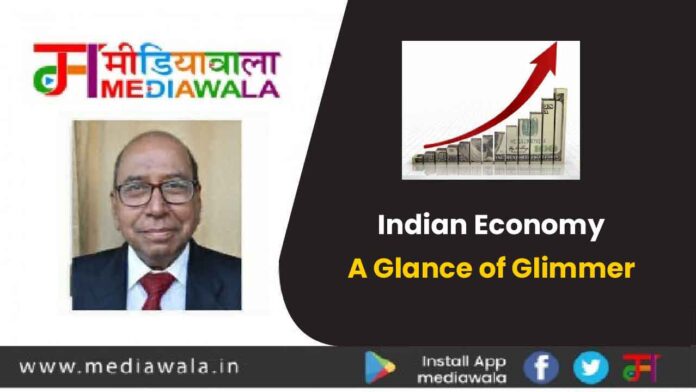
Indian Economy-
A Glance of Glimmer
Any analysis of economic situation of a vast country like India is riddled with perils. For the middle and poor classes here, the inflation is the pain of day to day life. The inflation is constantly much above the tolerable limit set by RBI of 6%. Mercifully it has now come down to 6.8% in October from earlier much above 7%. Unemployment or underemployment also present a grave challenge before India. The economic slowdown which was noticed in 2019–20 was heading towards great catastrophic challenges. The pandemic brought negative growth in the first half of the financial year 2020–21. Lockdowns in many countries resulted in a supply shock of the nature unknown to the World. When the supply was limping back to normalcy with the rising demand, the world witnessed Russia-Ukraine war as yet another big jolt. The countries like India needing energy from outside suffered inflation.
And yet there is something unique in Indian economy which has made it resilient to many headwinds. The RBI’s projection for GDP growth for this financial year is 7% – making India still the fastest growing emerging market in the world. A spectacular high GDP growth of India during 2004 and 2008 was helped by favourable international situation. In contrast at present UK, EU and US have confessed that recession has come in their countries. US Fed is following the policy of aggressive monitory tightening. This it is doing by increasing the bank interest rates to fight inflation. In other words to check the inflation the advanced countries are inviting recession. The policies of US Fed has led to the flight of dollars from other markets, weakening the currencies of other countries including rupee.
Then what is so peculiar with India that it will grow at 7% in spite of all above hindrances? There are several factors for this. In the last few years there had been restructuring of Indian economy on a scale not witnessed before. Weak and unviable firms are exiting while the healthy ones are flourishing with great pace. Indian commercial banks have been well capitalised and non bank finance companies have been revitalised. Digitalisation has helped create a strong financial infrastructure. The government is determined to dispose of its heavy loss making Public Enterprises. But the most significant factor is that the economic reforms have been coming over the years. Even during the pandemic India’s fiscal and monetary policies were steered well and economic reforms also continued. The substantial foreign currency reserves provided RBI the capacity for selling US dollar and controlling the inflation better than the advanced countries. These sane steps in economy, in an otherwise political turmoil and an increase in defence spending due to stand-off with China, has bewildered the world.
The macroeconomic data suggests that India will become the third largest economy by the end of 2027-28. The GDP growth of advanced countries Has stagnated while emerging markets are you still growing. Among the emerging markets India is the front runner. A study by Ruchir Sharma of the future of Chinese economy estimates that China can’t grow now more than 2.5% per year. As against this India is poised to raise its GDP somewhere 5 to 6% in the mid term. It is a great opportunity for India to shine in the world before its demographic advantage dwindles as it has already been in China.

एन. के. त्रिपाठी
एन के त्रिपाठी आई पी एस सेवा के मप्र काडर के सेवानिवृत्त अधिकारी हैं। उन्होंने प्रदेश मे फ़ील्ड और मुख्यालय दोनों स्थानों मे महत्वपूर्ण पदों पर सफलतापूर्वक कार्य किया। प्रदेश मे उनकी अन्तिम पदस्थापना परिवहन आयुक्त के रूप मे थी और उसके पश्चात वे प्रतिनियुक्ति पर केंद्र मे गये। वहाँ पर वे स्पेशल डीजी, सी आर पी एफ और डीजीपी, एन सी आर बी के पद पर रहे।
वर्तमान मे वे मालवांचल विश्वविद्यालय, इंदौर के कुलपति हैं। वे अभी अनेक गतिविधियों से जुड़े हुए है जिनमें खेल, साहित्यएवं एन जी ओ आदि है। पठन पाठन और देशा टन में उनकी विशेष रुचि है।






